
WARNING
--------------------------------------------------------
The distance between the hob and the lower
part of the hood must be at least 65 cm.
The air collected must not be conveyed
into a duct used to blow off smokes from
appliances fed with an energy other than
electricity (central heating systems, ther-
mosiphons, water-heaters, etc.).
Comply with the official instructions provided
by the competent authorities in merit when
installing the disposal duct. In addition,
exhaust air should not be discharged into
a wall cavity, unless the cavity is designed
for that purpose.
The room must be well aerated in case a
hood and some other heat equipment fed
with an energy other than electricity (gas,
oil, coal heaters, etc) operate at the same
time. In fact the intake hood, disposing of
air, could create a vacuum in the room.
The vacuum should not exceed 0,04mbar.
This prevents the gas exhausted by the
heat source from being intaken again. It is
therefore advisable to ensure the room
contains air taps able to ensure a steady
flow of fresh air.
Check the data label inside the
appliance; if the symbol ( ) is printed,
read the following: this appliance has
such technical particulars that it
belongs to class II insulation, therefore
it must not be earthed.
The following warning is valid in the United
Kingdom only: as the colours of the wires
in the mains lead of this appliance may not
correspond with the coloured markings
identifying the terminals in your plug,
proceed as follows:
– the wire which is coloured blue must be
connected to the terminal which is marked
with the letter N or coloured black;
– the wire which is coloured brown must
be connected to the terminal which is
marked with the letter L or coloured red.
– terminal of a three-pin plug.
Check the data label inside the applian-
ce; if the symbol ( ) is NOT printed,
read the following: ATTENTION: This
English
appliance must be grounded.
When
making the electrical connections, check that
the current socket has a ground connection.
The following warning is valid in the United
Kingdom only: as the colours of the wires
in the mains lead of this appliance may not
correspond with the coloured markings
identifying the terminals in your plug,
proceed as follows:
– the wire which is coloured green and
yellow must be connected to the terminal
in the plug which is marked with the letter
E or by the earth symbol [ ], or coloured
green or green and yellow;
– the wire which is coloured blue must
be connected to the terminal which is
marked with the letter N or coloured black;
– the wire which is coloured brown must
be connected to the terminal which is
marked with the letter L or coloured red.
When making the electrical connections,
check that the voltage values correspond
to those indicated on the data plate inside
the appliance itself.
In case your appliance is not furnished with
a non separating flexible cable and has no
plug, or has not got any other device ensu-
ring omnipolar disconnection from the elec-
tricity main, with a contact opening distance
of at least 3 mm, such separating device
ensuring disconnection from the main must
be included in the fixed installation.
Always switch off the electricity supply before
carrying out any cleaning or servicing
operations on the appliance.
USE
--------------------------------------------------------
Avoid using materials which could cause
spurts of flame (flambées) near the ap-
pliance.
When frying, take particular care to prevent
oil and grease from catching fire. Already
used oil is especially dangerous in this re-
spect. Do not use uncovered electric grates.
To avoid possible risks of fire always comply
with the indicated instructions when cleaning
anti-grease filters and when removing
grease deposits from the appliance.
MAINTENANCE
--------------------------------------------------------
Thorough servicing guarantees correct and
long-lasting operation.
Particular care must be paid to the anti-
grease filters which must be periodically
cleaned in relation to use (at least once
every two months). Remove the anti-
grease filters and wash them either by
hand or in the dishwasher using neutral
detergent. To take off the anti-grease filters:
at the handle, push the stop inwards and
pull the filter downwards (Fig.3); open the
trolley and take off the other filter doing the
same.
Any fat deposits should be removed from
the appliance periodically depending on
amount of use (at least every 2 months).
Avoid using abrasive or corrosive products.
To clean painted appliances on the outside,
use a cloth dipped in lukewarm water and
neutral detergent. To clean steel, copper
or brass appliances on the outside, it is
always best to use specific products,
following the instructions on the products
themselves. To clean the inside of the
appliance, use a cloth (or brush) dipped in
denatured ethyl alcohol.
DESCRIPTION
--------------------------------------------------------
The appliance can be a filtering version one,
a ducting version one or with an external
motor.
In the Filtering version (Fig. 1), the air and
vapours conveyed by the appliance are depu-
rated by charcoal filter and recirculated around
the room. ATTENTION: Using the hood as a
filtering one it is necessary to use the char-
coal filter that purifies the air sent back into
the room.
In the Ducting version (Fig. 2), cooking va-
pours and odours are conveyed straight out-
side by a disposal duct which passes through
the wall/ceiling. Use of charcoal filter is there-
fore unnecessary.
In the version with an External motor (Fig.
3), the appliance must be connected to an
ducting apparatus/motor which works on its
own using the appliance as a union for the air
to be scavenged. Use only motors pro-
posed in the original catalogue.
According to the model you have bought, the
appliance can include 1 or 2 motors. In the I
motor version the flange for the air to be
exhausted has not got a central position, but
it is slightly on the left.
INSTALLATION
--------------------------------------------------------
Before assembling, in order to manoeuvre the
appliance more easily, take off the anti-grease
filters: at the handle, push the stop inwards
and pull the filter downwards (Fig. 4); open the
trolley and take off the other filter doing the
same.
IMPORTANT: So as not to damage your
product, during installation USE ONLY THE
SCREWS PROVIDED. Make sure these are
used as shown in the following
instructions.
To compensate possible depth voids be-
tween the appliance and the wall, a plastic
SPACING BAR to be fixed at the back of
the appliance by means of the three
screws A is included (Fig. 5). The 3 screws
A to be used are contained in the acces-
sory bag attached to the plastic spacing
bar. Cut the spacing bar according to the
distance to be adjusted.
Assembly under a pensile cupboard
The following operations are essential for
assembly:
– Install the wiring system
– Prepare the air venting hole if your
appliance is to be installed in the ducting
version or in the version with an external
motor.
In the Ducting version and in the version with
an External motor, to get optimal conditions
the air venting pipe should:
– be as short as possible.
– have the lowest number of bends (max
bende angle: 90°).
– be made of material approved by local
authorities (according to the State).
– have its inner side as regular and smooth
as possible.
It is moreover recommended to avoid drastic
changes of pipe cross section (recommended
diameter: 125 mm).
Fixation as indicated in Fig. 6:
Using the relative template make the 4
necessary fixing holes in the bottom of
the cupboard and cut the air venting hole.
For the version with an External motor,
make the electrical connection between
the hood and the external motor by means
of the proper terminal board (Fig. 8): take
off the cable clamp A and the cover B of


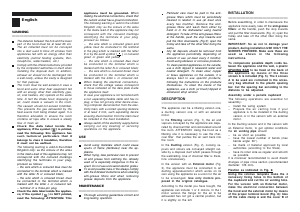

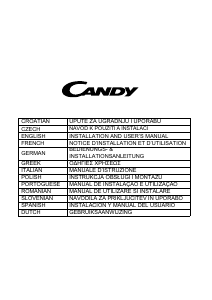
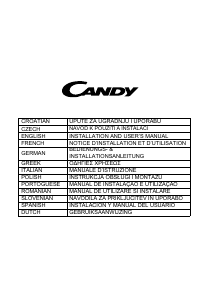
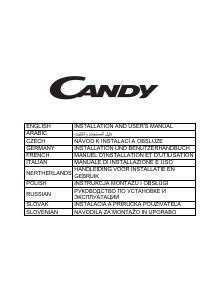
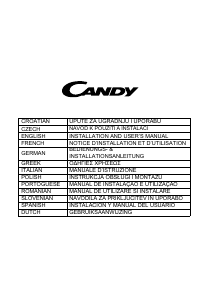
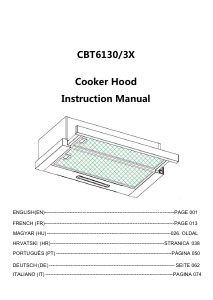
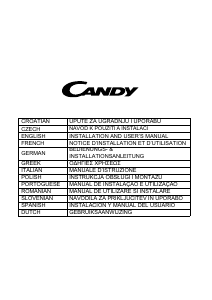
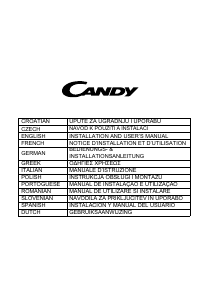
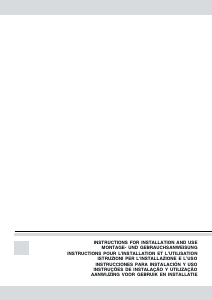
Partecipa alla conversazione su questo prodotto
Qui puoi condividere cosa pensi di Candy CACBT62/1N Cappa da cucina. Se hai una domanda, leggi prima attentamente il manuale. La richiesta di un manuale può essere effettuata utilizzando il nostro modulo di contatto.